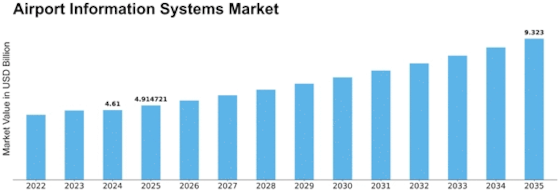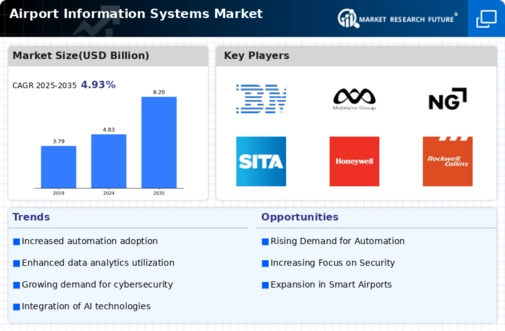Airport Information Systems Size
Airport Information Systems Market Growth Projections and Opportunities
Due to several market considerations, the airport information systems industry is growing rapidly. Demand for efficient and technologically sophisticated aviation solutions is a major motivator. Complex airport operations need seamless integration of passenger processing, luggage handling, security, and air traffic control systems. These procedures may be managed and optimized by airport information systems, improving operational efficiency. The USD 4.89 billion Airport Information Systems Market is expected to increase 4.11% by 2020-2030. Advances in technology shape the airport information systems industry. Airports are using cloud computing, AI, and the IoT to improve their information systems as the aviation sector digitizes. These technologies increase data analytics, real-time monitoring, and predictive maintenance, helping airports make educated choices and react quickly to operational changes. Airport information systems market size depends on regulatory compliance. Aviation authorities worldwide create and update legislation to assure air transport safety, security, and efficiency. Airport operators must follow these rules, and information systems enable them do so. Demand for sophisticated information systems that can respond to shifting compliance requirements drives market expansion as rules change. Another major airport information systems market driver is rising air passenger volume. Airports must properly manage passenger flows due to rising air travel worldwide. Information systems that streamline check-in, security screening, and boarding reduce wait times and improve customer satisfaction. Airports upgrade information systems to accommodate rising passenger numbers and boost throughput. Airport information systems market growth is driven by security and threat detection. Advanced technology are needed to detect and mitigate airport security risks. Airport security is improved via integrated information systems that link security cameras, access control, and screening equipment. Market growth is driven by need for better security-capable information systems. Smart airports and digital solutions drive the airport information systems industry. Smart airport projects use information technology to link airlines, ground handlers, and transportation authorities and communicate data effortlessly. These networked systems promote airport efficiency, cooperation, and resource utilisation. Budget and cost-effectiveness are key in airport information systems. Airport operators typically have budget constraints and want cost-effective solutions that satisfy their needs. Scalability, adaptability, and cost-effectiveness make information systems appealing to airports of all sizes and capabilities. Globalization and developing market air transport infrastructure growth shape the airport information systems industry. Modern information systems are needed to support the operational complexity of new and expanded airports. This tendency is especially noticeable in fast-growing economies with high air travel demand.










Leave a Comment